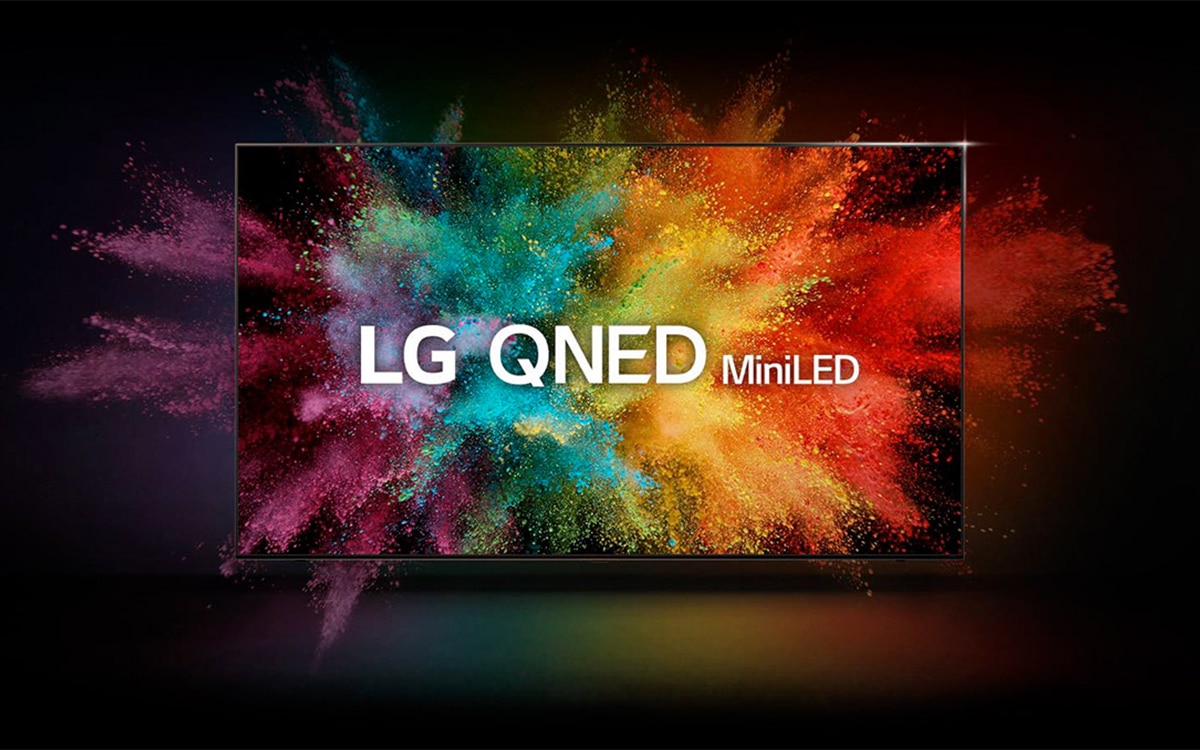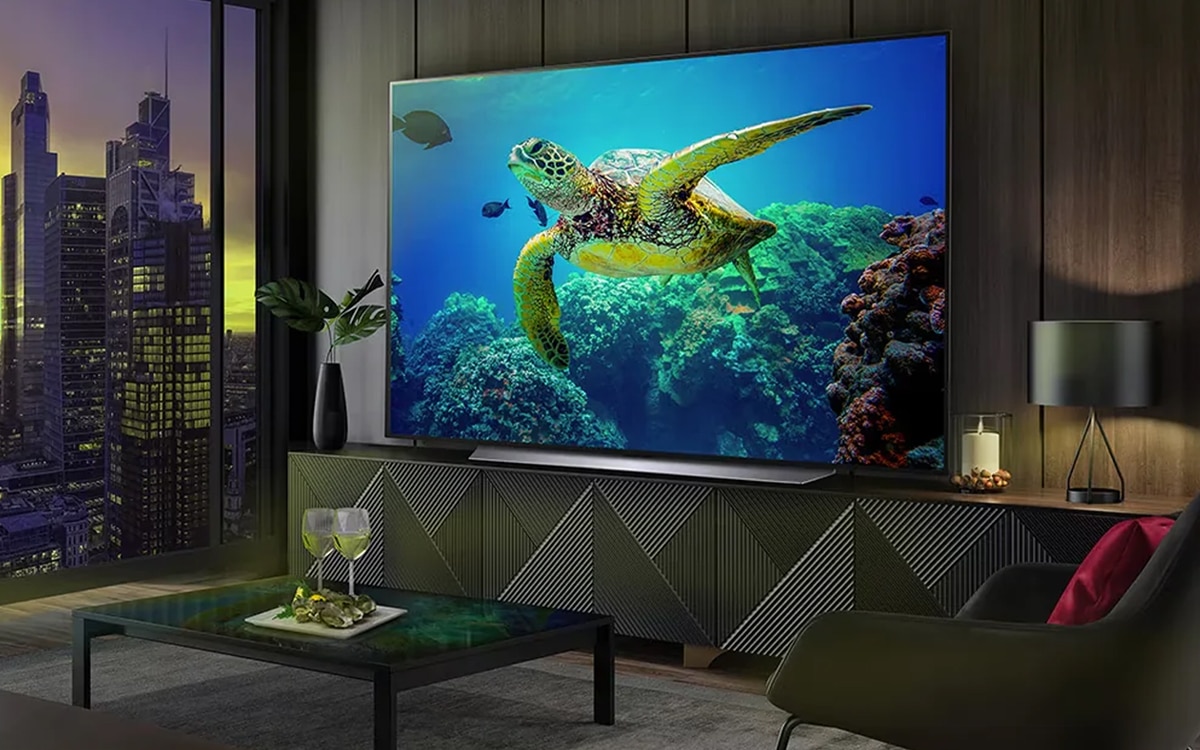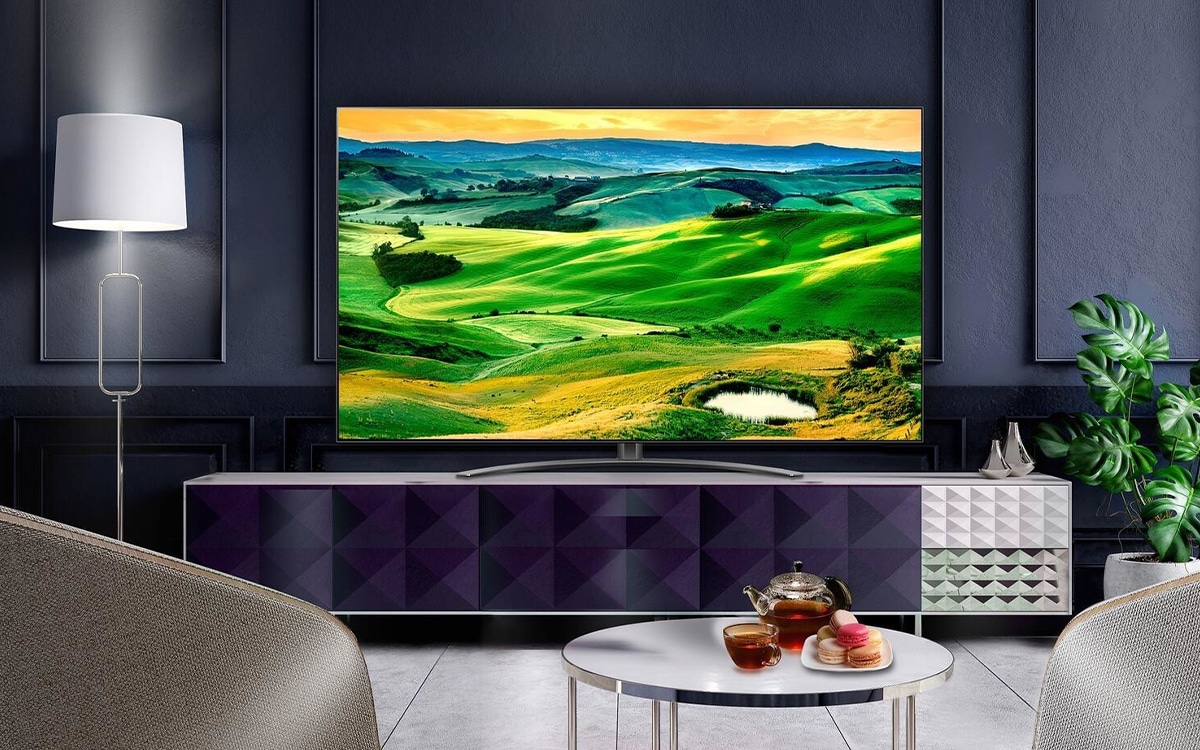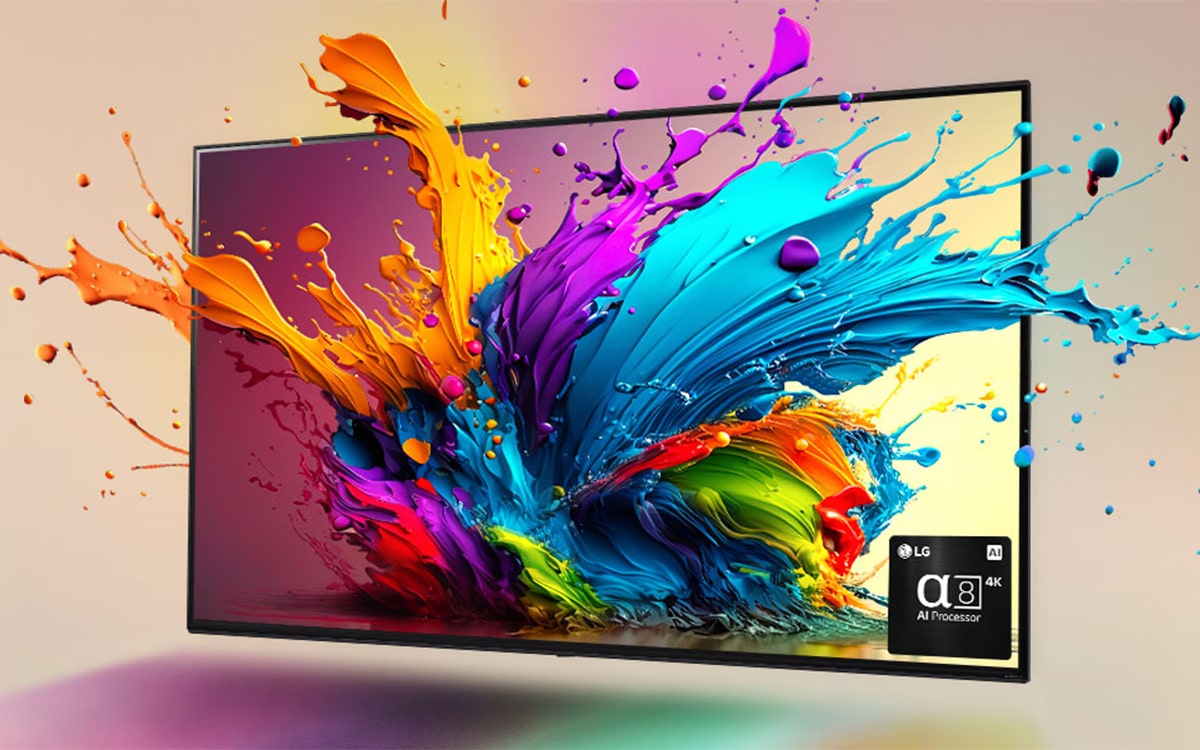It’s easy to get mixed up when trying to tell the difference between QNED and QLED TVs. Especially when their names are both so strikingly similar. But what is it that actually makes QNED TVs special? And how can you identify one at a quick glance?
Want to spare yourself the potential technological embarrassment of mixing up your TV display types? Then this is the guide for you! Through the help of our Reliant tech experts, we’ve put together the definitive guide to QNED TVs. So you can learn the ins and outs of these unique TVs, and understand what makes them such a considerable contender in such a populated TV market!
What Is A QNED TV?
QNED TVs actually operate very similarly to the closely-named QLED TV. This is because QNED TVs make use of quantum dots to display images.
Essentially, quantum dots are microscopic semiconductors charged with rendering the colours needed to display on-screen images. These semiconductors are actually so microscopic that they cannot be seen with the naked eye. This gives them a very natural look and results in colours that look incredibly real. To create colours, the quantum dots are electrified and then combine together in varying ways. Doing this causes them to emit specific wavelengths of light, which results in distinct colours!
Both QLED and QNED TVs make use of special quantum dots, which are specially engineered to be able to produce more realistic and vibrant colours. If you want more colour from your content, then quantum dots are for you!
Both QLED and QNED TVs then utilise LED backlights to shine extra light through the layer of quantum dots, creating the look of a finished image.
What differentiates QNED TVs from QLED TVs, however, is their inclusion of a special layer, between the quantum dot layer, and the very front of the screen. The NanoCell layer is responsible for improving the overall image, and overcoming some of the common shortcomings of QLED TVs. Let’s find out a little more about what makes the NanoCell Layer so special.
What Is The Difference Between A QNED TV And A QLED TV? – The NanoCell Layer
The NanoCell layer found in QNED TVs is specifically engineered to account for a very common problem faced by QLED TVs.
As we mentioned in our introduction, QLED TVs make use of LED backlights to project an image out to the viewer. While this does allow QLED TVs to be some of the brightest on the market, it does mean they have slightly worse contrast. Unfortunately, some of the light emitted from the LED backlights can bleed through the on-screen image. Through the darker areas of the on-screen image, in particular. This means that areas of an image that should appear a dark black, instead are more likely to appear a dull grey.
The NanoCell layer is specially designed to identify and absorb this excess light. To keep it from ruining the contrast of the finished image. This layer is placed between the quantum dot layer and the front of the screen itself. By absorbing excess light, the NanoCell layer allows a QNED TV to boast excellent contrast that makes every image look ten times better!
The NanoCell Layer found in QNED TVs is designed to absorb any excess light that comes from the LED backlight. This helps to enhance the contrast of the on-screen image.
QLED TVs have long lagged behind OLED TVs in terms of their contrast ratios. OLED TVs make use of self-illuminating pixels that can turn off completely when needed. This allows them to create true-to-life black values. QNED TVs are a kind of middle ground between both QLED and OLED TVs. They feature the amazing colour-replication abilities of QLED displays, backed up by stronger contrast more akin to an OLED TV!
Are QNED TVs Worth Buying?
Seeing as QNED TVs so deftly marry the benefits of both OLED and QLED TVs, we think they’re absolutely worth a purchase. QNED TVs are able to fully utilise the best of quantum dot technology to create images that are full of vibrant colour, and so much immense saturation. The inclusion of the NanoCell layer ensures that excess light doesn’t ruin the image by dampening any contrast.
QNED TVs, thanks to their high brightness, are fantastic for those who want to enjoy plenty of TV throughout the day. Higher brightness ensures the average QNED TV won’t have its image drowned out by ambient light. If your living room is often filled with daylight, then a QNED display is almost essential!
QNED TVs are also a great option thanks to how affordable they are. QNED TVs are often much more affordable than many similar OLED or QLED TVs. This makes them a fantastic option if you’re looking for a simple TV to add to a smaller space in your home. QNED TVs are also fantastic for those who may be buying their very first TV!
What Should You Consider In A QNED TV?
Think a QNED TV might be a great fit for your living room? Ready to grab one of your own? Then you’ll want to make sure to grab the right one!
When looking for the perfect QNED TV, there are a few key things that you absolutely need to consider first. Each of these features will help you to narrow down your choices, so you can find the model that perfectly suits all of your unique viewing needs!
Screen Size
We might as well address this right out of the gate. When most people set out to buy a brand-new TV, the first thing they think about is the size of the screen. In many ways, it’s the most exciting part of the process, imagining grabbing that super-sized screen you’ve always dreamed of. However, it’s of vital importance to exercise some restraint at this early point in the search.
You don’t want your new TV to be too big, much like you don’t want it to be too small. You need to make sure it’s just the right size for your home! It’s tempting to grab the biggest TV available, but if it’s too large for your space, you’ll actually have a less satisfying viewing experience! When your TV is too large, it becomes impossible to take in the entire image without having to whip your head around. You should be able to make out the entire TV image from your favourite spot on the sofa without having to move your head.
Make sure your new QNED TV is of the right size. Don’t be tempted to grab the largest screen around without first checking if it’s suitable for your home. If a TV is too big, it becomes uncomfortable to watch!
The best way to find out if a TV is a suitable size for your space is to remember this handy trick. Take the total screen size of a given TV, and multiply it by 1.2. The resulting sum is the amount of space that should be between you and the screen when you’re relaxing and reclining on the sofa. If there’s not enough space, the TV will be too big, and you’ll have to keep moving your head to follow the action!
Resolution
Next up, you’re going to need to consider your new TV’s resolution. No doubt, you’ve already decided to settle for a 4K or 8K model. If you’re opting for a TV on the slightly larger end of the scale, it’s a great choice to make!
Larger TV screens really benefit from higher resolutions. Images of a higher resolution are able to display at incredible scale without appearing stretched or pixelated. Luckily, 4K TVs are now much more affordable than they once were in their infancy.
The immense detail offered by the quantum dots of a QNED TV also benefit a lot from higher-resolution images. Not only will the images have a greater sense of fidelity, but they’ll also be packed full of colour that looks just like the real thing. QNED and QLED TVs are both prized for their ability to render colours that are realistic, and incredibly saturated.
If you’re grabbing a much smaller QNED TV for a bedroom, such as a 32 inch model, then there’s no need to grab an 8K resolution. At such a size, the screen would benefit more from 4K or Full HD.

Local Dimming Zones
There’s one feature that’s totally essential when looking at QNED TVs. A feature that helps to improve contrast, and make QNED TVs look even better: local dimming zones.
A TV with local dimming zones is able to dim the amount of light being sent to a specific portion of the screen, as needed. This, in turn, helps to improve contrast, and helps to lighten the load that the NanoCell Layer has to bear!
Local dimming zone technology is able to lower the amount of light emitted by specific backlights when needed. This helps to keep light from bleeding through the screen and ruining the contrast! It’s great for QNED TVs!
The more local dimming zones a TV boasts, the more accurately it can dim specific areas of the screen. As such, you might want to look out for a QNED TV with more local dimming zones!
Just make sure to keep in mind that the more local dimming zones there are, the more expensive the TV will be.
HDR
Many TVs sell themselves based on their ability to support HDR. But unless you know what HDR is, it can be tough to tell why exactly you should care.
At its most basic, HDR is a special format that is able to transmit video and audio signals with far more detailed information than average HD video and audio. Essentially, this results in your content both looking and sounding ten times better. HDR video allows your content to be displayed with a much wider range of colours, and even with a greater range of brightness levels.
If you really want to make the most of a QNED TV, then HDR should be considered absolutely essential. HDR truly leverages the abilities of QNED to create an unparalleled viewing experience. QNED’s ability to recreate realistic colours melds well with HDR’s ability to widen the spectrum available. And the greater brightness control offered by HDR works perfectly with QNED’s immense LED backlights.
Automatic Brightness
So far, we’ve made it pretty clear just how important the LED backlights of a QNED TV are. They’re a key part of the QNED experience, and they help to make the TVs much brighter than many other competing displays.
But of course, it’s very easy for a TV to be too bright or too dim for any particular situation. There’s nothing worse than switching on your TV in the dark of the night, only to be met with a screen at its highest brightness! Want to spare yourself the horror of being nearly blinded? Then it’s worth looking for a QNED TV with automatic brightness technology.
Certain QNED TVs come with built-in light sensors that can actively detect the amount of ambient light within the space. It then uses this key information to adjust the brightness of the display accordingly. If the TV notices there’s plenty of sunlight shining in through the windows, it will increase the brightness. If it notices that the room is darker, then it will automatically lower the brightness, to save you any eye strain!
Automatic brightness technology is a great addition to a QNED TV. This technology allows the TV’s brightness to adjust depending on the amount of ambient light in the space. It saves you the trouble of adjusting the brightness yourself!
This technology helps to take a lot of the guesswork out of the viewing experience. It also helps to reduce eye strain, and results in a much more comfortable view of your content!
Smart Features
Nowadays, you’d actually have a harder time finding a TV that didn’t boast smart features. Smart TVs are now the standard across the market. However, they can very much differ from model to model. Especially in terms of the features they offer. Certain smart TVs have certain features. So, when you’re looking for the perfect QNED TV, you’ll want to consider what kind of smart TV you want.
Be sure to take a look through a number of different models, to find out what smart features they boast. Some features might be more useful to you than others!
One feature we think really elevates the experience of a smart TV is voice control. With voice controls, you can easily interact with your TV without having to press a button. This makes it much easier to jump between content, so that there’s never a dull moment!
Price
Last but not least, is the price. The price of your new QNED TV should be fair and representative of what you’re getting. A good TV should never have you baulking at its price tag.
The best thing to keep in mind is that the more feature-packed a TV is, the more it will cost. This also accounts for screen size and resolution. As such, you should think carefully about the features you want from your smart TV. What’s the point of wasting all of that money to get a TV packed full of features you’ll never use?
Make sure you spend the right amount on your new TV. Don’t spend too much on a TV that’s full of useless features. But also don’t spend too little on a TV that’s unsatisfying!
But make sure you also don’t underspend. Don’t be afraid to splash a little more cash to grab features that are essential to you. For instance, if your TV would benefit more from a larger TV screen, then don’t saddle yourself with a smaller model just to save money!
Who Makes QNED TVs?
An interesting thing to note about QNED technology is that it was actually pioneered by LG. LG has long been at the forefront of TV technology, and they have long been a trusted name in the home entertainment industry.
Because QNED technology was created by LG, you’re more likely to find QNED TVs under the brand’s label. However, LG does produce LG screens for a number of other TV manufacturers, such as Samsung. Thus, you can head out and look for a QNED TV, confident that you’ll always find a trusty and solid TV.
Are QNED TVs Good For Gaming?
So far, much of this guide has been focused on the many benefits that QNED TV screens can offer content like film and TV. However, we’ve yet to touch on another popular use for TVs: Gaming!
Luckily, QNED displays definitely are not lacking when it comes to heightening the gaming experience and making you a better player.
Improved Clarity
The already-mentioned benefits of QNED displays make them great for enjoying games of all types. For instance, the incredibly vibrant and colourful screen is great for displaying some of the most immersive digital worlds in realistic detail. Want to truly soak in the sense of atmosphere as you look out at the game world from a great height? Want to feel a sense of dread as you venture through some of the best horror games? QNED displays can help!
The enhanced colour and contrast of QNED displays make them great for gaming. Triple-A story-based games become all the more immersive, as you can quite literally soak in every detail of the atmosphere!
The improved contrast of QNED screens also makes them good for those more competitive titles. Higher contrast leads to much clearer detail. In turn, this makes it much easier to spot the opposition from all the way across the game map!
Responsive Play
QNED TVs are also very responsive and smooth. They have incredibly low levels of input lag, so every time you press a button on your controller, you’ll see your in-game character react instantly. This is great for those online gamers who depend on split-second reactions.
QNED TVs also have solid refresh rates. Solid refresh rates are absolutely crucial for modern triple-A gaming, as they allow games to render at buttery-smooth frame rates. Luckily, QNED TVs totally have it where it counts in terms of refresh rates. With some models achieving refresh rates as high as 144 Hz.
So, not only are QNED TVs a great all-around option for enjoying TV and film but also for enjoying the best of gaming.
However, it must be noted that QNED TVs do not quite boast the response times that OLED TVs do. If you want a TV that is completely dedicated to professional gaming, then an OLED TV is the better choice. Many OLED TVs have response times well under 0.1 milliseconds. Making them some of the fastest on the market.
Are QNED TVs Susceptible To Screen Burn-In?
There are few things TV owners dread more than screen burn-in. Screen burn-in is a condition in which a static image gets, well, burned into the screen of a TV. This tends to occur when static on-screen elements are displayed for too long. The strain that these elements place on the TV results in an impression of them being left behind.
Though screen burn-in can occur on any TV display, it’s more likely on some than others. Luckily, QNED displays are very unlikely to develop screen burn-in. This is because they make use of backlights to create images.
Unlike OLED TVs, QNED TVs are not susceptible to screen burn-in. This is because they make use of backlights. If a single backlight burns out, it’s very easy to replace.
OLED TVs, on the other hand, are more likely to encounter screen burn-in thanks to how they operate. OLED displays are made up of millions of individual self-illuminating OLED pixels. Because these pixels provide their own light, it means they can burn out at different rates. This means it’s much easier for the impression of a static image to burn into the face of an OLED screen.

How Long Do QNED TVs Last?
Generally, a QNED TV will last anywhere between 50,000 to 60,000 hours of watch time. This is around 7 to 8 years of frequent use. This makes them among some of the more durable TVs on the market.
QNED TVs are very durable, and if you take care of them just right, they can very easily outlive the expected 7 to 8 year timeframe. But how can you ensure this? Just make sure to follow some of these top tips down below!
How To Help A QNED TV To Last Longer
Lower The Brightness
QNED backlights do a lot of the heavy lifting in making your content look so good. This is part of what has made them such a popular option. They can really pump out a lot of light, so you can watch even on the brightest of days.
However, the higher the brightness of your TV, the more work the backlights have to do. In turn, higher brightnesses can end up shortening the lifespan of your backlights exponentially.
To help your QNED TV to last longer, we recommend lowering the brightness as much as is comfortable. Not only will this prevent eye strain, but it will help those trusty backlights to last much longer!
Don’t Touch The Screen
Whether you’ve already chosen a spot for your QNED TV, or you still need to move it into position, you should be careful to not touch the screen.
You should try your best to avoid touching a QNED TV screen. Apply too much force, and you risk damaging one of the TV’s many layers. Damaging the NanoCell layer could result in low-contrast images that appear washed out!
Applying too much force to a TV can do direct damage to some of the highly important layers that make up the screen. In the case of a QNED TV, applying too much force to the screen could put the all-important NanoCell layer at risk of damage!
Give It Plenty Of Space
It’s easy to forget just how much heat a QNED TV can generate while in operation. To get rid of this heat, most TVs make use of a ventilation system. If this ventilation system is blocked or obscured, it becomes impossible for this heat to leave the unit. Over time, this will result in the TV overheating, which also directly shortens its overall lifespan.
To ensure your TV can keep cool while you use it, make sure to give it plenty of space. Keep those air vents unobstructed, and ensure there’s plenty of fresh air reaching the TV.
We also recommend occasionally grabbing a feather duster, and giving the vents a once-over. Dust can easily accumulate in these vents and block them, or otherwise get trapped amongst the internal components.
Turn It Off
We know we sound like an overbearing parent when we say this, but it cannot be understated how important it is to turn your TV off. Don’t worry. We’re not suggesting you keep it turned off forever. What would be the point of that?
Instead, we’re imparting the importance of turning the TV off completely whenever you’re not using it. It’s remarkably easy to end up leaving your TV on by accident. If you’ve ever accidentally left your TV on, you’ll know how shocking it is once you realise it!
Leaving your TV switched on when you’re not using it, whether accidentally or not, puts it at great risk. It will be using up all of that electricity and straining its components for no reason!
It’s a good idea to make use of a QNED TV’s built-in sleep timer. Especially if you’re prone to leaving it turned on! These are programmed to shut down your TV after a period of inactivity has passed.
Make a habit of turning off your QNED TV every time you step out of the room! If you’re particularly prone to leaving it on, then make sure to use the built-in sleep timer. This will automatically shut down the TV after a certain amount of time has passed!

Frequently Asked Questions
What Is A QNED TV?
QNED TVs are functionally very similar to QLED TVs. This is partly why they are so often confused with one another. They both use quantum dots to generate images with lifelike and rich colours. QNED TVs, however, differ thanks to their inclusion of a NanoCell layer. The NanoCell layer is responsible for absorbing excess light from the backlights. This results in much greater contrast!
Which Is Better OLED Or QNED?
OLED TVs are noted for their incredible contrast. They can create true black values, which in turn makes bright colours look much brighter. If you’re looking for a TV with truly strong and sharp contrast, then an OLED display is the best option. QNED TVs certainly have better contrast than their QLED counterparts. But they’re still not totally perfect.
What Are The Benefits Of QNED TV?
The key benefit of a QNED TV is the inclusion of the NanoCell layer. QLED TVs, which QNED TVs are functionally similar to, make use of backlights to project images out to the viewer. Unfortunately, some of the light from these backlights can bleed through the image. This makes darker images appear too bright. The NanoCell layer helps by absorbing this excess light. Protecting the contrast of the image.







0 Comments